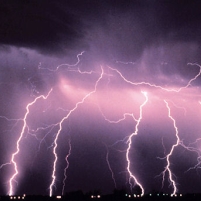In a Thunderstorm, It’s Dangerous to Live Downwind from a City
Thursday, June 02, 2011
 (photo: NOAA)
(photo: NOAA)
Cities have a way of altering the intensity of storms as they pass overhead and move downwind, according to researchers at Purdue University.
After analyzing 10 years of data from storms around the Indianapolis area, Indiana’s state climatologist, Dev Niyogi, concluded that urban centers can modify thunderstorms, causing them to become stronger and more violent as they leave the cities. Tall buildings, pollution and urban heat are thought to be significant factors in this little-noticed phenomenon.
“About 60 percent of the daytime thunderstorms seem to change their characteristics,” Niyogi told Purdue’s news service. “Before the storms approach the urban area, we see them as a more organized line of storm cells. As the storms get past the urban area, there are smaller but more cells, signifying splitting. So, quite often, we see storms approach the city, split around it and come back together on the other side to create a more intense storm.”
Niyogi’s assessment echoed that of a previous study performed 20 years ago using rainfall data from the St. Louis metro region. From that research, the National Oceanic and Atmospheric Administration found rainfall intensity and amounts increased from five to 15 miles downwind from city.
-Noel Brinkerhoff
Cities Affect Storms, But Downwind Areas Can Get the Worst of It (by Brian Wallheimer, Purdue University)
Thunderstorm Intensity Grows Downwind From Cities (by John Vogel, American Agriculturist)
- Top Stories
- Unusual News
- Where is the Money Going?
- Controversies
- U.S. and the World
- Appointments and Resignations
- Latest News
- Trump to Stop Deportations If…
- Trump Denounces World Series
- What If China Invaded the United States?
- Donald Trump Has a Mental Health Problem and It Has a Name
- Trump Goes on Renaming Frenzy






Comments